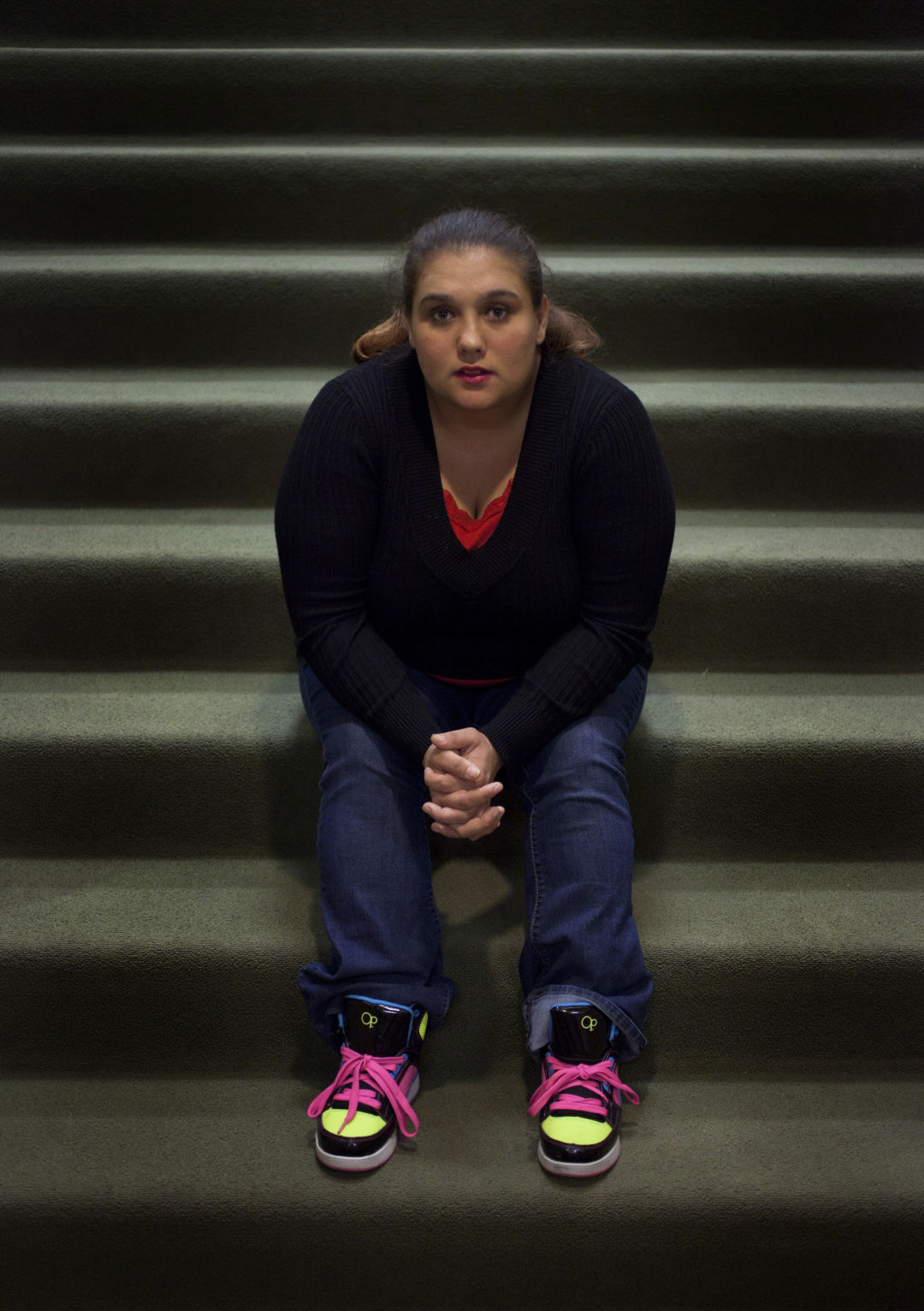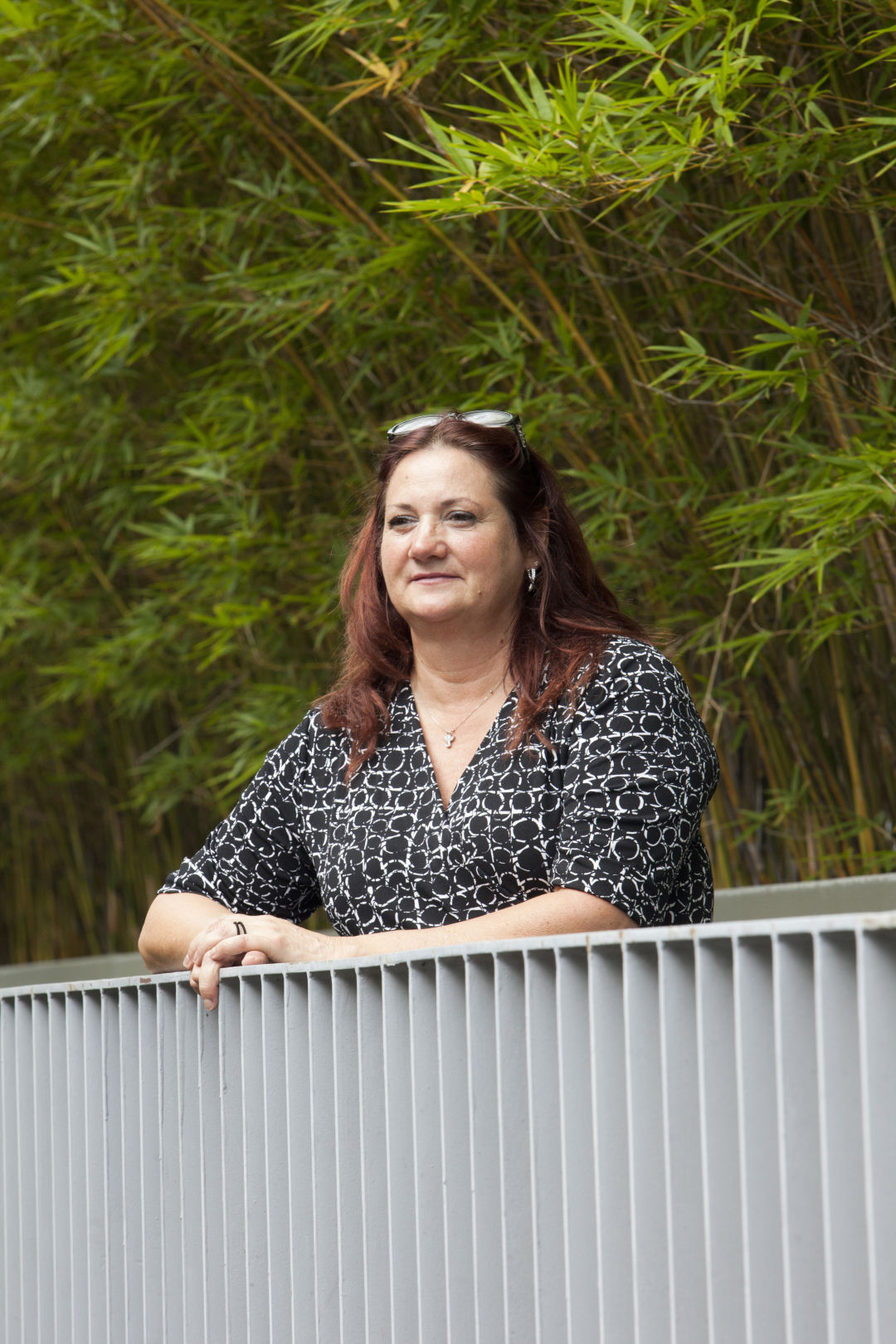
What Happens After a Life Spent in the Texas Foster Care System?
It was early July 2001, and Trish Virgil was going to make a lemon meringue pie. “In our family, 12 years old meant that you get to finally learn how to make homemade pies,” she says now, smiling.
But, Virgil says, when she got home from the store with her mother, police had surrounded their trailer. While they were out, Virgil’s older sister, 17 at the time, had called the police on their stepdad, who’d been sexually and physically abusing both girls for years.
Virgil, her sister, and their brother, who, at 13, was a year older than Virgil, would go directly into foster care, and not for the first time. When Virgil was 2 and the family was living in Phoenix, Arizona, the siblings were put into the state’s custody after their mom went on a drink-and-drug-fueled bender and left them unattended.
That first time, Virgil and her brother spent four years in care before reuniting with their mother; her sister arrived a year later. Then, after her mother met the man who would become Virgil’s stepdad at a Narcotics Anonymous meeting in Arizona, they eventually settled in Dobbin, an unincorporated community outside Conroe, in the late ’90s. That, Virgil says, is where the abuse began.
“All three of us were being physically abused,” Virgil, now 28, says today. “My stepdad would literally beat us with a belt and then ask us if we were bleeding yet.” She pauses, glancing down. “So.”
When the cops arrived that July evening, they separated the siblings and questioned them. “At the time, I had a bruise the size of a fly swatter on my arm,” Virgil says, “and when they asked me if my stepdad did it, I was honest with them.”
Although Virgil is well aware her stepdad was abusive—“all forms of abuse, verbal, sexual, emotional, physical, you name it, he was doing it”—she still sounds wistful when she talks about those pies, as if the key to the happy childhood she never had was wrapped up in that moment missed, when her mom would teach her to knead that flaky homemade dough.
Instead, Virgil and her siblings went back into the foster care system, embarking upon a long and winding journey under the care of the state’s Department of Family and Protective Services (DFPS). Although she’d escaped her stepfather, she would continue to undergo physical and sexual abuse for the next six years, as she cycled through roughly 10 homes in Montgomery and Harris counties, with 10 different caseworkers assigned to her. She would never permanently settle with a family.
Then it was over. In 2008, after completing high school, Virgil, 19, aged out of the state’s care. At first she slept on friends’ couches, bouncing from house to house. But soon, her welcome wore out. She was on seven different medications by that point, all prescribed to her while she was in foster care, which had side effects like uncontrollable twitching and body movements.
“I didn’t know how to take care of myself at all,” Virgil says. “Didn’t know how to drive, didn’t know how to cook, didn’t know how to order prescriptions. So I was basically lost. I was confused about everything.”
And that is how, in 2010, Virgil ended up getting back in touch with her mother, and moving back in with her—and her stepdad, who was now living as a registered sex offender due to his abuse of Virgil and her sister. “Whenever I moved in with my mom, he turned over a new page in life and he was trying to be like a father figure to me,” Virgil says, by way of explanation. Still, she adds, “I pushed him away a lot.” Anyway, she had nowhere else to go.
Soon, her relationship with her family—her sister, who was pregnant, had also moved back in—soured. Later that year, Virgil tried to commit suicide. Still, she stayed with her family until they kicked her out of their trailer in August 2012, and she ended up with no car, no job and nowhere to stay.
Like too many young people thrust into the world with no support system after years in foster care, she was homeless, and felt hopeless.
To be sure, there have been many moments along the way when Virgil missed opportunities to get help. At the state and county level, there are systems in place for foster youths who age out of care, but she was one of many who slipped through the cracks.
Starting at age 16, teens in foster care are encouraged to sign up for the state’s Preparation for Adult Living (PAL) program, which offers budgeting and driver’s education classes, housing assistance, and other services until the young person reaches 21 years old.
In Harris County, much of that work happens at the Houston Alumni and Youth (HAY) Center. Funded in part by the state-run DFPS, which oversees Child Protective Services (CPS), the center serves about 1,000 foster and former foster youth, placing a special emphasis on the 200 who age out in Harris County each year. (The county’s CPS Project Court also has a PAL docket dedicated to keeping tabs on them and educating them about the help they’re entitled to.)
Mary Green, the HAY Center’s director of transition services, says the goal is to help youth access their benefits, like a one-time $1,000 stipend and a “transitional living allowance,” which puts some money toward a young adult’s room and board after they leave care. The classes PAL offers aren’t mandatory, Green says, but they’re required in order to receive the $1,000 stipend.
“But just like any young person who is told something at 15 or 16 but never gets to practice it or actually do it, they forget a lot,” Green says. “That’s why a lot of them, they’re just not prepared when they leave foster care. Which, none of us were prepared. But the big difference is that you and I had a family there to support us and pick us up. These kids do not have that, and because of that—that’s what we are, basically. This is where they come when they’re in that crisis or when they realize, ‘okay, I’m at a crossroads.’”
And the rate of success? “It’s not perfect,” Green says. “It’s probably not great. But have they developed resources, ways to cope, do they know what to do in a crisis? Because we see them a lot less as they get older. So they’re learning and coping.”
Virgil says she never got her one-time stipend, but briefly received room and board assistance, which went to the mother of a friend that she stayed with after leaving care. The classes, she adds, just didn’t get through to her at the time. “It was basically just, they gave us a book, they talked about the stuff in the book, and that was it,” she says. “We really didn’t learn essentials that we needed, no.”

Image: Daniel Kramer
In 2012, at 23 years old, Virgil met Sandra Carpenter. Over the next five years, their relationship would have its ups and downs. But Carpenter succeeded in getting through to Virgil, and Virgil let Carpenter help her.
Carpenter has three biological and eight adopted children. Always active in her foster-parent association, she’s fostered 65 kids, many with serious medical conditions, over a 16-year span. In 2008, with another adoptive parent, Debbie Zempel, Carpenter founded a non-profit organization called Angel Reach, with the aim of supporting kinship placements, in which kids are fostered or adopted with relatives.
Back in 2010, Angel Reach threw an event for current foster kids, where, in addition to taking part in activities like rock-climbing and manicures, kids could attend informational sessions. That’s when Carpenter began to understand the predicament of foster children who don’t find permanent homes.
“These kids kept coming up to me and asking me, ‘Do you know where I can go when I get out?’” she remembers. “I’m like, ‘Get out of where?’ They meant out of foster care. I was just like—‘Oh my god, where do they go?’”
She’d never thought about it before. “I kind of got a view of the whole system, but the part I didn’t know about was the aging-out part, because I either adopted, or my kids went back home or went onto adoption,” she says.
Soon, Angel Reach expanded its mission to include a transitional program to support aged-out youth, many of them homeless, in and around Montgomery County.
Sitting in her office in Angel Reach’s nondescript Conroe building, Carpenter explains that at first, the idea was to help young people access the state and federal benefits they’re entitled to, for things like college-tuition waivers and room-and-board stipends.
But she and Zempel soon realized they needed to start with the basics. Very few former foster youths have things like driver’s licenses and bank accounts, let alone the ability to sign an apartment lease. “We quickly learned that there was no concentration on anything permanent,” Carpenter says, “when you don’t have anywhere to live.”
Today the organization offers housing to its members, whom they accept after they age out of care but before they turn 24, with no hard and fast rule about when assistance ends—some continue to receive it through their twenties.
Virgil was under the cutoff age when, after falling out with her family and then severely spraining her ankle, she lost her job in the cafeteria at Kingwood Medical Center and found herself living at the Salvation Army. Through Conroe’s Tri-County Services, she spoke with a free mental health provider who referred her to Angel Reach.
And when Virgil limped into Angel Reach’s Conroe facility on crutches, it really was the basics she was after. She needed somewhere to sleep that night.
Virgil walked Carpenter through her story—of her abuse at the hands of her stepfather, and her subsequent hellish seven years in the system.
In 2001, when she and her siblings were removed from their family for the second time, they started out in a shelter with about 20 other kids of all ages. There, Virgil says, she was jumped by a pack of girls. “They used to play the choking game,” she explains. “It’s where they push back on your vocal cords and make you ... basically choke you until you pass out.”
While Virgil’s sister was moved to a higher-security residential treatment center, she and her brother spent more than a month at the shelter before moving to a temporary placement. During that time, according to Virgil’s case file, their mother terminated her parental rights. “They wanted my mom to jump through hoops in order to get us back,” Virgil says, “and my mom just didn’t want to jump through those hoops.”
Next, 12-year-old Virgil and her brother went to a group home, with six other kids, run by a married couple. Within a couple of weeks, Virgil would later testify in court, her foster dad began coming up to her room whenever they were alone and touching her. “I had a card from my caseworker that said if anything happens, to call this number. I tried to call it and report it, and they said, ‘Okay, we’ll look into it,’” she says. “And nothing ever happened.”
Months later, she finally moved from the house, and away from her brother, after having a physical altercation with her foster mother that was witnessed by a caseworker. “My foster mom literally pinned me down; she was sitting on my shoulders and she was pulling my hair. And I had enough of it at that time, going through that,” Virgil says. “I looked at my caseworker and I said, ‘You either get me out of here today or I’m running away.’”
Virgil hopped around several short-term placements until she ended up at an all-girls group home run by an older woman who, Virgil says, was kind. It was there that she spent her high school years before aging out and ending up, more or less, right where she’d started, living with her abuser.
Virgil’s story was, of course, maddening. But Carpenter had heard it all before. “When I started doing transitional living with youth, and I started hearing their stories about their experiences being in foster care and growing up in foster care, I thought, wow, this is really sad. I’m sorry this happened to you, this is terrible,” she says. “But then when you’ve done it for years and you hear the same stories from hundreds of kids, then you know there’s a systemic problem. It is not isolated.”
Carpenter enrolled Virgil in Angel Reach’s assessment center, where—like all of its participants—she was evaluated for mental and behavioral issues and had to adhere to a strict set of rules.
“In the assessment center we have a curfew, 7 o’ clock. And there’s no visitors. It’s a safety issue, because we don’t know yet who we’re dealing with,” Carpenter says. “We also want to see if people are willing to listen. Because if they can’t hear you, there’s nothing we can do.”
From there, Virgil moved to group housing, and then to a deeply subsidized apartment—the tiered housing program features five houses and seven apartments, which are home to around 40 young adults, including some pregnant women and young children. Most pay $200 a month, half of which is retained in a savings account so they’ll have a nest egg when they’re ready to leave.
In order to stay in the program, members must work toward a set of goals established early on, which include saving for a car (also deeply discounted through the program), attending school, and finding steady work.
“Honestly, I was scared,” Virgil says, remembering crafting her goal sheet with Carpenter. “But in another way I was also motivated, because I needed somebody that could support me and my mental health, and help me get on my feet.”
In 2014, after Virgil had been with Angel Reach off and on for two years, New York–based foster advocacy group Children’s Rights approached Carpenter. Three years prior, the organization had brought a class-action lawsuit on behalf of Texas foster children who’d been permanently placed in the state’s care and whose rights, it maintained, had been violated. Carpenter, Virgil and a group of other young adults involved in Angel Reach agreed to testify.
Virgil made the decision to participate after reading a copy of her case file, which included reports made by her foster mother about her inappropriate behavior with men, including an instance in which Virgil sat close to a visiting salesman, cross-legged. “I had to motion to her to sit back and put legs together,” the foster mother wrote. That was doubly hurtful to Virgil, she says, in light of the call she’d made to report the sexual abuse by her foster father in that same home, which she says went unreturned.
“It says on there I was being provocative, I was asking for it, I was wearing provocative clothing. I was a 12-year-old little girl,” she says, her voice rising. “So, I mean, that’s the main reason why I was part of the lawsuit. It’s because of that—that shouldn’t be happening to anybody. Especially somebody that just got out of that situation.”
Filed in 2011 on behalf of the 12,000 Texas children in “permanent managing conservatorship,” the suit includes those kids who’ve been in the state’s custody for longer than a year.
Central to the filing is the rate of turnover in caseworkers—statewide, 20 percent of them quit, for example, in the first three months of 2015—and the danger children face due to the lack of sufficient oversight. Contributing to the high turnover rate is the job’s low starting salary, around $32,000. Those who don’t leave, meanwhile, are rewarded with ever-increasing caseloads that have no cap.
The lawsuit takes to task the shuffling of children from home to home, often in different parts of Texas. In 2009, it alleges, 6,400 children had been in the state’s custody for more than three years, moving to an average of 11 different placements, severed from their schools and communities again and again. The suit also cites inadequate supervision, too much medication, too little therapy, too little effort to find permanent placement, and a lack of support for kids who age out.
The main takeaway, though, is this: Far too often, what happens to children within the system—emotional, physical and sexual abuse—is as bad or worse than what caused them to enter it in the first place.
Virgil, age 25, took the stand in Corpus Christi on December 3, 2014. She told Judge Janis Jack, who presided over the case in U.S. District Court, about the abuse she experienced while in care, first at the shelter where she was beaten by other girls and then at her group home, where her foster father sexually abused her.
Marcia Lowry, an attorney for Children’s Rights, asked Virgil how many caseworkers she’d had in the seven years she was in foster care.
“About 10,” Virgil replied.
“Did this turnover in caseworkers have any effect on you?” Lowry asked.
“A lot of times, whenever I had issues in some of the homes, I didn’t know who to go to, I didn’t know who to trust, so I just—most of the time I kept my mouth shut,” Virgil told her.

Sandra Carpenter runs a transitional program to support aged-out youth.
Image: Daniel Kramer
Carpenter took the stand later that same day, speaking as an expert witness. She told the court that life as a foster child in Texas is isolating, not like a normal kid’s life. “How many people would you have to pay to take care of children, to take them to their first job, to teach them to drive, to teach—to, you know, go cut wood or go swimming or do things like that?” she asked the judge.
She told the court about an Easter dinner she hosted when she watched young adults unsure of how to use a knife, because they hadn’t been allowed to hold one before; about getting calls from young adults in the Angel Reach program who don’t know how to turn on their oven or load a dishwasher. “Those are all activities that children grow up in this country and do every day, except when they’re in foster care,” she told the judge, “because there has to be a limited amount of grownups to take care of a group of kids.”
Carpenter’s always been a little outspoken about the system, she says. “These kids are removed from people who have hurt them or not taken care of them, and they are on a ride through the system of moving, losing things, losing people, losing connections … and then abuse on top of it?” She shakes her head.
She’s traveled to Austin numerous times over the last four years, testifying to legislators. “They sit there and they hear their stories and they cry, but then nothing ever happens,” she says. “The lawsuit was a way to make something happen.”
And happen, it finally did. In December 2015, Judge Jack found that the state of Texas was violating long-term foster children’s constitutional rights, stating in her ruling that children in Texas “often age out of care more damaged than when they entered.” She appointed two outside specialists, paid for by the state, to draft a spate of reforms, which include limits on group homes like the one where Virgil says she was abused, and a cap that would cut caseworkers’ loads in half.
Texas officials haven’t taken the ruling, or the recommendations, lying down—in November, it was reported that the state has spent $7 million fighting it. Nevertheless, the U.S. Fifth Circuit—considered to be one of the most conservative in the nation—has rebuffed multiple appeals by the state.
While the situation is still playing out in court, a recent filing by Attorney General Ken Paxton, brought in November, contends the state doesn’t have room in the budget to make the necessary changes to the system and that it doesn’t need federal oversight to improve the DFPS.
In January, Judge Jack issued an interim order ahead of a final one, instructing the state to make plans for a database that catalogs young people in care long-term, a hotline for them to call in case of abuse, and a policy pairing each child with his or her own lawyer, among other actions. The state has pushed back again, asserting that any measures taken should be brought by Texas’s own elected officials.
But given the slew of recent negative headlines—which have highlighted the occasional need to house foster children overnight in DFPS offices due to a shortage of placements for them, as well as reports of months-long delays investigating abuse—an increasing number of state legislators admit the department is broken.
For his part, last April, Governor Greg Abbott tapped Hank Whitman, a former Texas ranger, to head up DFPS. Since coming on board, Whitman has called for hundreds more caseworkers and a new approach to contracting foster-care services—to be rolled out quickly—which some say is an effort to ward off larger-scale reforms.
While Whitman has called for merit-based raises for caseworkers, some Texas Democrats are pushing for an across-the-board increase; the issue is expected to be addressed during the state legislature session currently in progress. Whatever happens, DFPS is facing a $40 million budget shortfall, and experts don’t see reforms sticking without a sizable influx of funds.
As for the caseworkers themselves, a group of current and former employees took to the capitol last year to urge Texas to stop appealing the lawsuit’s ruling and get to work reforming the system. “Our ability to do our job is undercut by the unmanageable workloads that we are saddled with,” caseworker Susan Rial said at the time. “There simply aren’t enough hours in the day for us to spend on each child, family and client.”
Fresh off her shift at a daycare center in The Woodlands, wearing her work-issued green polo and khakis, Virgil walks into Angel Reach headquarters. She grabs a plate of pasta and garlic bread, cracks a Coke and settles into a seat alongside more than a dozen other former foster kids, all of whom get free dinner for attending life-skills classes. This one’s on personal finance, and Virgil listens as a woman from a local bank explains the ins and outs of credit histories, savings accounts and buying a car.
A bit sheepishly, Virgil asks the instructor what to do if your credit history is ruined by a family member. “My mom put the trailer she was renting in my name and got evicted,” she says. “Now I can’t put my name on a lease.” The instructor tells her she could press charges, since that’s illegal, but Virgil just shakes her head. “Is there anything I can do that won’t get my mom in trouble?”
Today, Virgil’s considered a “day client” at Angel Reach, attending classes from time to time and getting support when she needs it. Since first walking in the organization’s doors back in 2012, she’s had varying levels of involvement with the group.
Her first stint lasted a year, until a disagreement with Carpenter on her goal sheet led Virgil to try life on her own, at age 24. Then, another year passed, and she had to have ankle surgery, causing her to lose her job and get evicted—a second strike on her credit record.
Virgil found herself sleeping in a motel room, considering heading back to the Salvation Army. “I didn’t want to tell Sandra because I was kind of ashamed. But someone else told Sandra, and she contacted me and asked me to come in and speak with her,” she says. “I was homeless and on crutches again. It was like a déjà vu moment. She encouraged me to reapply, and I did.”
That time, Virgil moved into a one-bedroom apartment in a quiet complex in Conroe with Carpenter’s name on the lease, with Virgil paying the full $570-a-month rent and the electric bill, because, due to Virgil’s age, she couldn’t re-enter the housing program. That lasted for about six months, but last October, after Virgil missed two months’ rent, Carpenter says she had to ask her to find a new place to live. Virgil’s since rented a room in someone’s home.
“We had put in the lease that there was no grace period,” Carpenter says. “We try to work on things that have been problems for them before so that they’re very clear…. And she’s had issues with money before. If you don’t pay your rent, you’re going to have to leave.”
Carpenter says this sort of thing is the norm. “Our goal,” she says, “is that they leave here with a job that is putting them above the poverty line, that makes 16 to 20 dollars an hour. That counseling has resolved their trauma, that they have a car.” But it takes years before she sees people “getting over addictions, solving criminal-history problems, domestic-violence issues, counseling issues, credit-history issues, paying back loans,” Carpenter says. “It just takes that long to get traction. They come with a lot of stuff.”
And some issues don’t go away. “I know people who are 50 years old and they still have problem areas,” she says. “Some kids, it’s managing money, some kids it’s trust, some it’s relationships, some it’s anger management. They can kind of get it all together, but there’s a part that they keep getting in trouble with over and over.”
She sighs. “Trish’s biggest problem to this day, her biggest challenge, is letting people help her or teach her how to do the grown-up stuff. So it’s been a struggle because she kind of gets to a certain point and then she’s like, ‘I got this,’ and takes it over, and gets herself in a bind,” Carpenter says.
Virgil says she moved out this last time because she wants a cat, and more freedom to have people stay over for as long as she likes, something her lease agreement with Carpenter prohibited. “I’m going to try to become independent,” she says, as she approaches 30. “It’s time to make some big steps.”
Those include two clear goals for her future: to lease a newer car, and to go to college for early childhood development, something that’s always been her dream. She loves kids, loves her job at the daycare, and hopes to stay there as she moves forward with her schooling. “I love how I can teach them things that they should learn, and I act like a kid on occasion, too,” she says. “It’s fun to play with them, and seeing their eyes light up when they see me is just awesome.”
Her mom and stepdad moved to Oregon, Virgil says, and they haven’t talked much since then. She says her relationship with her sister, who’s lost custody of her children, is beyond repair, but she still has good feelings toward her brother, who’s joined the Navy.
When she thinks about how far she’s come, Virgil says, she feels proud. “Yeah, I’ve made mistakes, but I’ve always found ways to correct the mistake and learn from it. I feel like there’s some things that still need tweaking. But it’s manageable.”
Read more about a local judge trying to do right by kids in the Texas foster care system in "Finding a Path Forward After Aging Out of Foster Care."













































